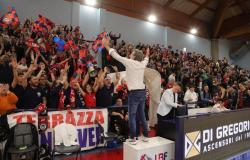A thousand years ago, on 19 April 1024, Romano of the counts of Tusculum, brother of Pope Benedict VIII († 1024), was elected Pope with the name of John XIX.
At the time of his election he was still secular, holding the positions of «consul, duke and senator of all the Romans». During his pontificate, he crowned Emperor Conrad II, known as the Salic (26 March 1027), became involved in the conflicts between the patriarchal sees of Aquileia and Grado, and showed support for the reformist positions, favoring the Abbey of Cluny. The details of his death are not known, which probably occurred on 20 October 1032.
Guido d’Arezzo lived under Pope John XIX (d. 1050), a Benedictine monk at Pomposa Abbey, known for his innovations in Western musical notation, before which the learning and transmission of liturgical melodies occurred primarily through oral memorization. The famous musical theorist, «called to Rome by the Roman Pontiff, made known his ingenious system thanks to which liturgical songs, originating from the ancient centuries, could be more easily disseminated and integrally preserved, for the good and decorum of the Church and of‘art itself. In the Lateran Palace, where in the past Saint Gregory the Great, after having collected, ordered and increased the treasure of sacred melody – the legacy and monument of the Fathers – had wisely established that famous Schola to perpetuate the genuine interpretation of liturgical chants, the monk Guido carried out a demonstration of his marvelous invention in the presence of the Roman clergy and of the Supreme Pontiff himself who, fully approving the‘initiative and warmly praising it, he worked to ensure that the‘innovation could slowly spread everywhere and extend to every genre of music” (Pius Divine cultus, 20 December 1928).
It is Guido who, together with the fundamental principles of his musical theorytells us this episode, which perhaps occurred in March 1027, inEpistle Guidonis Michaeli monk of unknown song (also known as Epistle to Michaelem), to his brother monk Michael of the Abbey of Pomposa:
Summæ Sedis Apostolicæ Johannes, qui modo Romanam gubernat Ecclesiam, audiens famam our scholæ, et quomodo per nostra Antiphonaria inauditos pueri cognoscerunt cantus, valde miratus, tribus nuntiis me ad se invitedvit. Adii igitur Romam cum domno Grunwaldo most reverend Abbate, et domno Petro Aretinæ ecclesiæ Canonicorum præposito, viro pro nostris temporis qualitate sanctissimo. Many Pontifex meo gratulatus est adventu, fine colloquens et diverse perquirens: nostrumque velut quoddam prodigium sæpe revolvers Antiphonarium, præfixasque ruminans regulas, non prius destitit, aut de loco in quo sedebat, abscessit, donec unum versiculum inauditum sui vows compos edisceret, ut quod vix credebat in alis, tam immediately in se recognosceret.
John, Supreme Pontiff of the Holy Apostolic See, who now governs the Roman Church, hearing the fame of our school and how the boys, through our Antiphonaries, knew songs they had never heard, was very amazed and invited me to him through three envoys. So I went to Rome with the most reverend Abbot Grunvaldo and with Pietro, superior of the Canons of the Church of Arezzo, a most holy man for our times. The Pontiff congratulated me greatly on my arrival, talking about many things and asking various questions: scrolling through our Antiphonary as if it were something portentous, meditating on the established rules, he did not move from his place until he had learned, as he wished, a verse he had never heard, so as to recognize in himself what he barely believed possible in others (our translation).
During the meeting, Guido shows the Pope his Prologus in antiphonarium, a small introductory manual to books of liturgical chant, written with the new notation system he promoted, of which he explains the principles on which it is based. The student had to associate the first syllables of the first verse of the hymn to St. John the Baptist (UT queant laxis – REsonare fibris | MIra gestiorum – FAmuli tuorum | SOLve polluti – LAbii reatum – Sancte Iohannes), text by Paolo Diacono († 799) and melody specially composed perhaps by Guido, to the sounds of an ascending scale of six notes (natural hexachord).
It will be the Spanish mathematician and musical theorist Bartolomeo Ramis de Pareja († 1522) to introduce the “Si”, taking it from the two initials of Sancte Ioannes in the last hemistich of the hymn, and Giovanni Battista Doni († 1647), literary and musical writer, to change “Ut” with “Do”, taking the first syllable from his surname.
With Guido’s method, the association between the syllables (Ut, Re, Mi, Fa, Sol, La) and the intonation of individual sounds remains firmly imprinted in the memory and can be recalled when necessary. By studying the intervals and becoming familiar with them, anyone could sing a written melody at first sight or transcribe it after hearing it.
Pope John XIX was fascinated by Guido’s teaching innovations and invited him to return to teach at the renowned one schola cantorum of the Lateran. This ecclesiastical school, which tradition claims to be founded by Pope Saint Gregory the Great († 604), was located in a monastery attached to the oratory of S. Stefano de Schola Cantorum near the Lateran Baptistery. There schola cantorum Lateran attracted young people from every Western European country. Here they studied music and classical culture, received minor orders (the ostiariate, the lectorate, the exorcist and the acolyte) and participated in solemn religious ceremonies and significant events of city life. Some historians suggest that Pope Saint Leo II (d. 683) was part of or even led this school. The influence of schola cantorum Lateran in the development of medieval music and poetry is demonstrated by the fact that many collections of hymns and songs originated precisely from it.
Perhaps John XIX was a “mediocre pope who did not understand the strictly religious dimension of his office” (A. Torresani, History of the Church, Milan 2018). However, among his criticisms of his pontificate, his fundamental role in supporting Guido of Arezzo cannot be overlooked.
Tags: Pope John XIX Guido dArezzo thousand years





